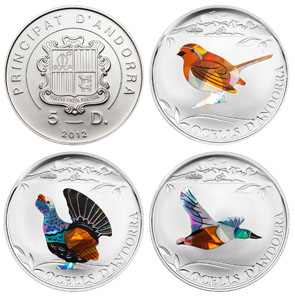August 23, 2012 – Andorra dedicates an issue in silver and copper-nickel to three of its characteristic birds. Coin Invest Trust has succeeded in utilizing an iridescent prism technique to render the birds’ gorgeous plumage.
Andorra, each: 5 Diners / 2012 / silver .925 / 20 g / 38.61 mm / Mintage: 2,500.
On the obverse the coins show Andorra’s coat of arms, in the exergue the face value in Diner, the currency of the Principality’s collector coins, is listed: ‘5 D.’ on the silver issue and ‘1 D.’ on the copper-nickel coins. Beneath the year of issue is stated: ‘2012’. Around the edge the official name of the issuing country is imprinted: ‘PRINCIPAT D’ANDORRA’.
The reverses are designed in similar fashion: the centre illustrates the respective bird in coloured prism technique,the superior part shows an outlined landscape with buildings, mountains, the sun, and flying birds. A stylised ground and leaves in the exergue hint at the birds’ habitats. An inscription in Catalan follows the inferior edge to the right: ‘Ocells d’Andorra’, Birds of Andorra.
The three different species of birds represent the diversity of Andorran bird life. The smallest of them is the Robin, that sings from the earliest hours of the day until twilight enchanting the neighbourhood with its charming song. As a short-distance migrant it winters in particular in the gentler coastal climate of Southern Europe. The characteristic orange plumage on breast and face is as visible on the coins as it is in nature.
Caipercaillie. Photo: Richard Bartz, Munich aka Marko Freak / Wikipedia http://creativecommons.org/licenses/by-sa/2.5/deed.de.
The Capercaillie has become a rare species in Central Europe. However, Andorra’s mountains still harbour a population of this timid grouse. Capercaillie cocks may grow up to one meter in length and weigh around five kilograms.
The Shoveller owes its name to the conspicuous bill, that is disproportionally large even on young ducklings. The Shoveller is strongly migratory, and only winters (among other areas) in Andorra while breeding generally occurs further north. Ornithologists are often able to identifiy this species of duck by its characteristic flapping sound alone.
The prism technique has been successfully employed for many animal motifs of the Wildlife Protection series in the past. In this new issue the Coin Invest Trust demonstrates once more how the beautiful prism rendering can portray the beauty of nature, birds, and their plumage in all its glory.
If you can’t remember the robin’s chant, listen to it here.
Watch a shoveller here.
If you are interested in what other kind of birds live in Andorra you will find quite a comprehensive list on the Wikipedia site.
Coin Invest Trust offers a lot of information on the company and their products.






